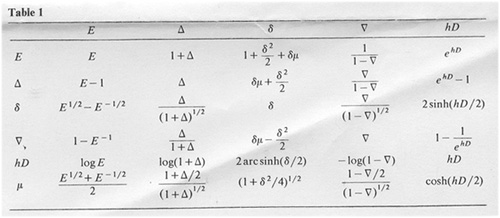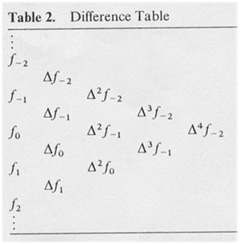 , where h is the grid size, the values
, where h is the grid size, the values  of the function f(x) are known. The difference
of the function f(x) are known. The difference  are then called finite differences of first order. Furthermore, we define the differences of order k + 1 inductively by
are then called finite differences of first order. Furthermore, we define the differences of order k + 1 inductively by  . If we use the shift operator E defined by
. If we use the shift operator E defined by  , the difference operator is represented as
, the difference operator is represented as  . Sometimes the backwards difference
. Sometimes the backwards difference  is
is  , the operator
, the operator  is called the forward difference. The central difference
is called the forward difference. The central difference  which is defined by
which is defined by  is also used.
is also used.

Table 1 shows the relations between the finite differences and the differentiation operator D defined by
 .
. Table 2, in which each entry after the second column is the
Table 2, in which each entry after the second column is the  or
or  we can express each entry of table 2 in terms of
we can express each entry of table 2 in terms of  or
or  . For example, in the second column,
. For example, in the second column,  is equal to
is equal to  and
and  . If f(x) is a polynomial of degree k, then
. If f(x) is a polynomial of degree k, then  f(x) is a polynomial of degree
f(x) is a polynomial of degree  is a constant, and
is a constant, and  is zero. Therefore, looking at the difference table, we can find the degree of an interpolation polynomial that can satisfactory approximate f(x). It should also be noted that, if the computation of each entry of the table is carried out with a finite number of significant figures, the error in the values
is zero. Therefore, looking at the difference table, we can find the degree of an interpolation polynomial that can satisfactory approximate f(x). It should also be noted that, if the computation of each entry of the table is carried out with a finite number of significant figures, the error in the values  is multiplied by binomial coefficients corresponding to the location in the difference table.
is multiplied by binomial coefficients corresponding to the location in the difference table.The following are interpolation formulas for which the difference table is used. Suppose that we want to interpolate the value
 at
at  . Then from
. Then from  , we have Newton's forward interpolation formula:
, we have Newton's forward interpolation formula:
Similarly, from
 , we have Newton's backward interpolation formula:
, we have Newton's backward interpolation formula:

 and proceeding downward to the right or upward to the right. On the other hand, by proceeding in a zigzag manner, downward to the right, then upward to the right, then again downward it the right, etc., we get another formula, called Gauss's forward interpolation formula:
and proceeding downward to the right or upward to the right. On the other hand, by proceeding in a zigzag manner, downward to the right, then upward to the right, then again downward it the right, etc., we get another formula, called Gauss's forward interpolation formula:
Similarly, we have Gauss's backward interpolation formula:

In addition to these formulas, there are several by Everett, Bessel, Stirling, and others, which are essentially equivalent to the Lagrange interpolation polynomial that uses the same tabular points, although the representations are different.